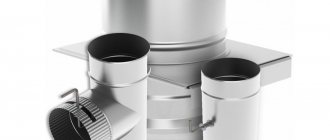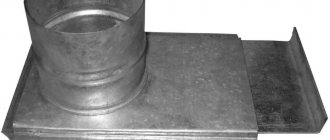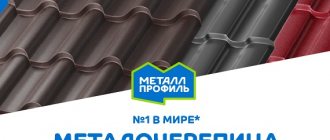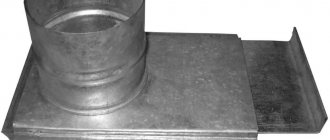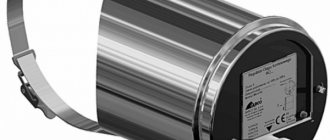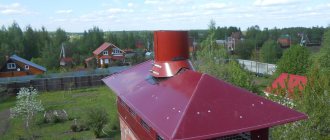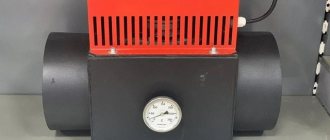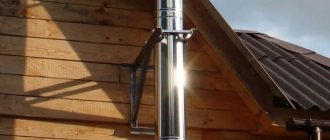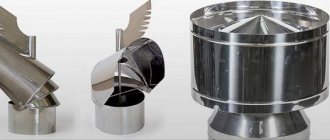Purpose
To understand why a damper is needed in a chimney system, you need to study the scope of application of the device. It is used in pipeline systems where it acts as a shut-off valve. The gate serves as a flow limiter for liquids and bulk mixtures. From the scientific side, such a device is called “change-over”.
By installing a valve in a system that provides the ventilation process, the device is used as a regulator of air mass flow. By moving the damper horizontally, the amount of air consumption that overcomes the obstacle in the form of a structure changes. Thus, a partial or complete partition is created in the path of air flow. The device is called “regulating”.
In a chimney system, a damper device is installed as a control element, which ensures partial or complete blocking of the smoke channel. This reduces the heat loss generated inside the steam room after combustion. The damper provides regulation of the traction force, since it acts as a damper in the direction of smoke movement. As the cross-section of the chimney pipe decreases as a result of the damper moving deeper into the structure, the traction force decreases. When completely blocked, it stops completely. When the gate element completely opens the channel for the movement of smoke, the draft increases, the combustion process occurs better, and the room heats up faster.
How to make and install a damper in a chimney yourself
As a rule, a chimney damper is installed in the chimney during its construction. Moreover, in order to make it convenient to use the damper, it is placed on the first meter of the chimney. To prevent the gate from jamming, under no circumstances should you insulate the area where it is located. We can say that the damper is the initial part of the chimney, and only after it does the pipe itself begin.
It is with the help of a gate that it is easiest to regulate the draft. There is absolutely nothing complicated about this, and anyone can understand this tool.
If you are building a brick stove, then the damper for the bath must be installed in this order. First you need to lay out the first row of the chimney out of brick. Then, laying out the second row, you need to cut out a fragment for the valve. Then you need to cut a groove for the handle in one brick.
The most important thing in this whole process is to lay out the second brick row as carefully as possible so that there is not the slightest gap in it. If cracks do appear, they must be filled with cement mortar.
The damper can be installed in the chimney even without fastening, since it will be held in place due to its tight fit to the structure.
Expert advice
Where to install the damper on the chimney
There are 3 options for placing the damper relative to the chimney:
- Placement in the firebox of a fireplace or stove;
- Fastening according to the “pipe to pipe” principle;
- Installation in a ventilation pipe.
Let's consider the first 2 options:
By placing the valve in the furnace firebox or in the outlet pipe
In this case, the damper is located at a height of no more than 1 m from the firebox, on an uninsulated section of the pipe. This location is convenient for adjusting the damper.
Applicable for metal chimneys. This installation option does not require additional fasteners. When purchasing a ready-made system, you should install the valve strictly according to the manufacturer’s instructions.
How to adjust traction
Adjusting the draft using a slider is quite simple. By changing the position towards increasing the gap, we increase the flow of air to the fire and the flame flares up stronger. Reduce the gap - traction decreases. The valve is closed after the flame has completely died out - this way the oven cools down much faster.
Selecting a location option
There are several ways to install a gate, each of which has both pros and cons. An important factor is what the chimney is made of. But modern masters prefer to use the three most common options:
- Installation in a fireplace insert.
- Fastening using the “pipe in pipe” method.
- Installation in a ventilation system.
The damper can be installed in the ventilation system. If the master has chosen the “pipe-to-pipe” installation type, he will not need to use special fasteners to securely fix the damper with the fireplace elements.
The location of the damper in the ventilation system completely eliminates the possibility of overheating of the fan motor during active operation. Modern manufacturers offer ready-to-install chimneys that are equipped with all the necessary devices (the slide damper is no exception). In this case, the part must be used in strict accordance with the recommendations established by the manufacturer. Otherwise, you can make a chimney damper with your own hands and at a more affordable price.
We suggest you read: What to do if concrete freezes
There are three main options for placing the damper in the chimney:
- pipe-to-pipe fastening;
- placement in a fireplace insert;
- installation in a ventilation pipe.
Brick chimney with damper
If you place a gate valve in the outlet pipe or in the furnace firebox, that is, build this element into its design, the damper is placed on a section of pipe as close as possible to the heating boiler. This guarantees ease of control and ease of turning the valve. This is explained by the fact that the handle will not touch either the portal or the cladding area. If it is located according to the “pipe to pipe” option, no additional fastenings are required for connection with other elements of the furnace.
Typically, ready-to-install chimneys are offered, which are equipped with everything necessary, including a slide valve. In this case, it is placed in the system in accordance with the manufacturer's instructions. If it is not provided for one reason or another, it is quite possible to manufacture and install this element yourself.
Do I need a damper for a chimney?
How to make a damper for a chimney. Damper chimney homemade.
Homemade stove damper in a cast iron pipe for a country stove
Types of gate valves
There are two main types of gate valves - sliding and rotary (throttle). The design features are clear from the name: the first type works due to the perpendicular movement of the metal plate relative to the chimney pipe.
We recommend that you read: How to make a spark arrestor for a chimney with your own hands?
To increase draft, the damper is moved back and almost completely extends beyond the chimney, and to reduce the flow it is pushed back into the pipe.
Retractable gate
The most popular damper for a retractable type chimney. It compares favorably with other varieties in terms of reliability and ease of use. The retractable gate is a plate with a smooth, even surface, in which there is a special longitudinal hole. It runs along the grooves in the chimney.
This type of valve is installed strictly horizontally. To change the draft force in the chimney, it is enough to move the damper in the desired direction, increasing or, conversely, reducing the cross-section for the pipe.
This option is suitable for steel pipes, but is more suitable for stoves made of brick. Its installation does not require special knowledge or significant effort.
Some models provide a small cut-out area. This ensures the safety of the structure: even if this valve is completely closed, the movement of carbon monoxide in it will continue.
Rotary gate
Another type is a rotary gate. It is a plate made of metal, which is fixed in the central part of the guide by welding.
Dimensions and principle of operation of the rotary gate
Its main portion is located in the inside of the chimney, but the tip should always remain outside. Against the background of rotation of this plate relative to its own axis, the draft in the chimney is regulated.
The disadvantage of this type is the need for fastening by welding. It is this place that is the weak point of the design: the damper will open if the fastening becomes loose.
The rotary gate is characterized by low reliability. But this indicator may vary depending on what it is made from. Most often it is used for installation in steel chimneys. It is also installed in cases where there is not enough space to extend the classic valve.
Cast iron gate
Cast iron dampers have found quite wide application in various types of stoves and fireplaces. The disadvantage of such products is their significant mass. At the same time, cast iron itself has been used for a long time in the production of valves for furnaces. This is explained by its high reliability, durability and strength.
Model range of cast iron gates
Steel type gate
A gate unit made of stainless steel is not the cheapest option. But the design is characterized by high quality and excellent performance characteristics. Its advantages are as follows:
- maintaining furnace efficiency;
- small weight;
- long service life;
- not subject to metal corrosion;
- prevents soot accumulation.
These gates may have different designs depending on the characteristics of the furnace. They are relevant for chimneys made of steel or brick.
Technical characteristics of the gate
The gate valve is a thin metal plate that is manually adjusted using a special handle. The latter is located outside the chimney pipe so that the user can manually adjust the position of the plate.
Depending on the design and type of damper, it is installed using a special metal frame, or is inserted inside the pipe and fixed with an axial rod.
The damper in the chimney performs the following functions:
- increases traction force in difficult weather conditions;
- increases the intensity of combustion in the furnace due to increased oxygen flow;
- reduces draft when there is a strong hum in the chimney during strong winds;
- saves fuel by reducing combustion intensity;
- prevents heat loss after the heater has warmed up.
To understand the purpose of this part for the chimney structure, you need to understand what a damper in a stove is. The damper provides a change in the traction force in the unit by adjusting the combustion of fuel in the firebox.
This element has an important advantage - it has low resistance relative to the remaining gas bubbles, which must be removed outside the room. When the chimney is inoperative, then the damper is completely closed. For the manufacture of gate valves for stoves and fireplaces, stainless steel is most often used - steel that is least susceptible to corrosion processes
The thickness of the metal should be one millimeter
For the manufacture of gate valves for stoves and fireplaces, stainless steel is most often used - steel that is least susceptible to corrosion processes. The thickness of the metal should be one millimeter.
This device allows you to control and regulate the draft into the smoke exhaust system. Translated from German,
gate (“schieber”) means a part that is made of a certain metal.
To eliminate these dangerous and unpleasant moments, a slide damper is installed in the smoke exhaust system. It prevents the fission of gas bubbles that should not be separated.
It is recommended to install a slide damper when heating with gas, coal, or solid fuel.
Being the main draft regulator inside the chimney, the damper regulates the combustion of fuel. To reduce the draft and reduce the intensity of the flame in the firebox, it is enough to close the slide valve. To increase traction, on the contrary, it is necessary to open it.
In fact, a gate is an ordinary metal plate that allows you to regulate traction.
It can be installed both in single-wall and double-wall boiler systems.
As a rule, the valve is installed at the initial section of the chimney (on the first meter), since this particular section remains uninsulated.
But on the contrary, it is not recommended to install a valve on a section of a well-insulated chimney pipe. Especially when it comes to double-circuit pipes. When the metal of the inner and outer pipe expands, the gate valve may jam.
So, the main tasks of a gate valve are:
- Function of the draft regulator in the chimney.
- Partial blocking of the chimney channel section.
- Regulator of flame burning intensity in the firebox.
Automation for boiler control
The modernized control system greatly facilitates the use of domestic and industrial boiler equipment.
The main components of the control unit are:
- blower fan;
- controller;
- draft regulator;
- circulation pump.
Additionally, they can be equipped with water level sensors, fuel level and consumption sensors, pressure recorders, safety valves, as well as an alarm that is triggered if the temperature level exceeds the permissible installation range (25-50 ⁰C).
Principle of operation
The automation for heating devices works simply and clearly:
- controls the blower;
- controls the entire volume of air entering the combustion chamber;
- ensures optimal combustion mode.
Unlike previous models, in the new improved devices there is no need to constantly open the ash pan door manually and monitor the temperature using a thermometer. For this they have a draft regulator. This is a very convenient energy-dependent device that automatically opens and closes the door in accordance with the temperature of the water contained in the container.
Instead of a standard damper, a fan controlled by a controller is installed. Its task is to supply exactly as much air to the combustion chamber as is necessary for full and safe operation.
The preferred coolant temperature level is adjusted using a controller with a screen and remote control. In order to maintain the temperature in accordance with the climatic conditions of the street, you can install an additional system with remote controllers and outdoor air sensors.
The fuel is ignited using an electric glow element built into the burner.
Advantages and disadvantages of use
A small number of sensors and instruments keep the combustion process of any type of solid fuel under control, maintain the temperature set by the owner and guarantee safety.
The most important useful functions and advantages of using automation include:
- rational and economical consumption of solid fuel;
- increasing the performance of the heating device;
- ensuring safe operation;
- no need for independent combustion control;
- increasing the interval between scheduled technical checks of the device;
- constantly maintaining the temperature in the heating system at the required level;
- automatic shutdown of the boiler in case of failure of any of its parts - based on a signal from sensors.
Automated systems also have disadvantages, but they are minimal:
- high price, which directly depends on the number of available options;
- the need to purchase an uninterruptible power supply due to the energy dependence of the control unit.
Advantages and disadvantages
Like any engineering solution, a gate has a number of advantages and disadvantages.
Pros:
- Possibility of traction control;
- Fuel economy;
- Dampers help retain heat.
Minuses:
- The devices make it difficult to clean chimneys;
- If installed incorrectly, the gate may jam and negatively affect the movement of gases;
- To make the correct adjustment, you must have some knowledge in the field of smoke exhaust systems.
Draft regulator for solid fuel boilers: selection and installation
Why do you need a draft regulator for solid fuel boilers and how to install it?
Solid fuel boilers, unlike devices using other types of fuel, are more difficult to control because they are highly inert. This may result in excess heat being generated. To regulate the intensity of fuel combustion, a draft regulator is used.
Operating principle of the draft regulator
The mechanical draft regulator operates on the principle of thermomechanics and does not require a power supply. This allows it to be used in energy-independent heating systems using solid fuel boilers.
It maintains the set coolant temperature by changing the position of the damper, which supplies air to the combustion chamber. With limited oxygen supply, combustion intensity decreases and excess heat is not released.
This eliminates overheating of structural elements, which allows you to increase the service life of the boiler. If the temperature in the pipeline needs to be raised, the damper opens slightly, increasing the access of oxygen to the flame. The draft regulator consists of the following elements:
- frame;
- lever arm;
- immersion sleeve;
- plastic handle with scale;
- thermocouple;
- steel chain.
The working material in the thermostat expands or contracts when the coolant in the boiler heats up and cools down. Changing its size affects the lever, which changes its position. As a result, the damper opens or closes.
Advice! The disadvantage of solid fuel boilers is their short combustion time. By loading a portion of fuel, you can ensure the operation of the heat generator for 3-4 hours. To extend the burning time, you need to reduce the air flow into the firebox. This can be achieved using a draft regulator.
Device installation
The draft regulator can be installed vertically or horizontally on the boiler. It depends on where the hole is provided for its installation. Installation is easy and quick:
- If installed horizontally, the fixing screw must be in the up position.
- If vertical installation is intended, the fixing screw should be on the rear side.
- When you take the draft regulator out of the package, you will find that the lever has been removed. This is usually done to make the packaging smaller. The lever must be secured with a locking screw in a suitable position so that the screw is on the flat part of the lever.
The chain must be secured so that its position between the lever and the air damper is vertical. Initially it is attached only to the lever. Attaching to the damper is done during setup.
Advice! The instructions for the regulator indicate the maximum damper weight allowed when using the regulator
This should be taken into account when choosing a suitable draft regulator.
Setting the draft control
Before setting, you need to make sure that nothing prevents the damper from opening and closing freely:
- Set the desired temperature on the handle (for example, 60 °C), using a suitable scale depending on the horizontal or vertical position of the regulator.
- Heat the coolant in the boiler to the set temperature, monitoring the process using the built-in thermometer. The damper must be open.
- Having reached the desired temperature, fasten the chain to the damper so that it is open by 1-2 mm. Check chain tension.
- Secure the position of the handle with a screw.
The instructions for draft regulators from different manufacturers may contain instructions that differ from each other. Always follow the instructions for your specific model.
To effectively use a solid fuel boiler, it is necessary to be able to regulate the temperature of the coolant in the heating system. To do this, use a draft regulator that allows you to change the intensity of fuel combustion by limiting the access of air to the combustion chamber.
https://masterotopleniya.ru
Features of wood burning
To ensure high-quality heating, you need to know how to heat a solid fuel boiler with wood efficiently and economically. For kindling, chips are laid down, on top of which you need to place 3-5 firewood with a diameter of up to 15 cm. It is recommended to lay crumpled paper between the chips so that the wood flares up faster.
After the first fire has ignited, the firebox is filled with large firewood. To achieve the most complete and efficient burning of wood, you can place 1-2 large logs in the firebox at intervals of 30-40 minutes. In addition, this method will help reduce firewood consumption.
When the firebox is completely filled with large firewood, an ordinary modern solid fuel boiler is capable of maintaining fairly intense combustion for 3-4 hours. Long-burning boilers operate on one burner even longer. It is generally not recommended to burn such models with small wood, which does not burn completely due to increased gas emission. The optimal size of logs in diameter is 15-30 cm.
If you figure out how to properly heat a TT boiler, then the choice of firewood is of great importance. Wood moisture content should not be higher than 20%, otherwise the efficiency of the equipment will be lost. In some cases, to increase the burning time, damp wood is specially placed in the firebox, which takes longer to burn. However, it must be taken into account that this leads to increased release of tar, which settles on the walls of the firebox and on the chimney, and this causes deterioration in draft. As a result, the boiler has to be cleaned more often. In order for firewood to have an optimal level of humidity, it must be dried under a canopy for approximately 1.5-2 years before use.
If you want to increase the burning time of one bookmark, then you should not use damp firewood, but set the correct position of the gate valve and thermostat. These provisions for each TT boiler model are determined experimentally.
Device, classification and requirements
A chimney or chimney is a special channel used in various buildings to remove volatile combustion products of solid fuels. It is usually a straight pipe of round cross-section, as this allows for maximum draft and minimal accumulation of soot on the walls of the chimney pipe.
Various requirements apply to the gas exhaust system, such as:
- Good traction;
- Availability of thermal insulation;
- Easy installation and maintenance;
- Long service life;
- Corrosion resistance;
- Smoothness of the inner walls;
- Fire safety;
- Aesthetic appeal;
When choosing a chimney for a solid fuel boiler, you should take into account the temperature of the combustion products. Depending on this parameter, you should select the material of the chimney pipe
Modern manufacturers produce modular chimneys from materials such as:
- stainless steel;
- ceramics;
- plastic;
- glass;
Photo 1: External installation of a chimney in a country house
The temperature of the flue gases at the outlet of the TT boiler can reach 600 degrees Celsius. Therefore, a steel and ceramic chimney is quite suitable for use in conjunction with a ZOTA solid fuel heating boiler. The use of glass and plastic chimneys is not allowed, since these materials are designed for significantly lower gas temperatures.
Separately, it is worth noting the classic brick chimney. The aggressive environment that arises inside such a structure quickly renders it unusable. That is why they give way to more modern devices.
Most often, stainless steel is used as the material for the manufacture of chimney pipes. The use of steel gives such a device a number of undeniable advantages:
- has low weight compared to brick;
- easy to install and assemble;
- does not require foundation construction;
Photo 2: Installation of a ceramic chimney in a country house
Stainless steel chimneys according to the type of construction are divided into the following types:
Single wall
Such chimneys are a regular steel pipe. The advantage of this design is its low cost. The main disadvantage is the formation of condensation on the inner surface and, as a consequence, its freezing at sub-zero temperatures.
Double-walled (or double-circuit)
The design of such a chimney is a “pipe-in-pipe” design. A smaller diameter pipe is placed inside the main pipe, and the space between them is filled with heat-insulating material. The advantage of this design is the presence of thermal insulation that protects the chimney from the formation of condensation, but the disadvantage is that the price of such devices is much higher.
The chimney design in the form of a sandwich pipe has recently gained particular popularity. This design is a chimney assembled from individual meter-long pipes, the joints of which are equipped with heat-insulating material.
Photo 3: Stainless steel chimney sandwich design
Special requirements are placed on the wall thickness of a steel chimney. When used in conjunction with TT boilers, the wall thickness of the chimney should be 1 mm or more.
Ceramic chimneys are also used to remove combustion products from a solid fuel boiler. Like steel, they are resistant to high temperatures and aggressive environments. The thickness of their walls is much greater (1.5 cm), and therefore they are much heavier and require installation on a foundation. Also, ceramic chimneys must be strictly vertical. The presence of various bends is excluded. This feature in some cases makes the installation and installation of such a chimney impossible.
Chimneys for a gas boiler in a private house: how to make them correctly with your own hands
When installing a gas boiler, the question always arises about the removal of gas combustion products from the room where the boiler is installed. This device must comply with current safety regulations.
Firms designing a gas heating boiler for a private home develop drawings taking into account the requirements of the gas service. Only if the chimney is made correctly will it be allowed to use gas for heating purposes in a private house.
What is it and why is it needed
The chimney does not always work perfectly. Often, due to its large length, too much draft occurs in it (vacuum, pressure drop); in windy weather, gusts of wind cause pressure surges; when the chimney warms up (kindling), the draft also increases.
It is almost impossible to control short draft surges, and they can harm heating equipment - for example, they can knock out the flame in gas boilers, and frequent inclusions and flashes of gas during ignition harm them.
Too strong draft reduces the efficiency of the heating unit - part of the heat does not have time to heat the heat exchanger or the furnace itself and “flies away” along with the exhaust hot gases. In addition, strong draft often causes the chimney to hum and disturb the residents of the house.
To eliminate pressure surges and excessive draft in the chimney, they came up with a draft stabilizer - a simple device. It is installed in the lower part of the chimney.
What affects cravings?
Causes of thrust variability:
- If the chimney head is lower than the roof ridge, then the direction of the wind affects the draft. Although the calculations used to determine the height of the chimney ensure that the pipe exits above the wind pressure zone and provides sufficient minimum draft under all conditions, this does not ensure stable draft - when the wind is directed along the ridge or wall of the house, it increases. Yes, and rounding all indicators (length and cross-sectional area of the hog) when calculating upward also increases the vacuum in the chimney.
- Depending on the weather, the draft also increases or decreases. In clear weather, the pressure is close to normal; with precipitation and humidity, the pressure drops. At high atmospheric pressure, the relative vacuum, that is, the vacuum compared to atmospheric pressure in the chimney increases, and at low pressure it decreases.
- In cold and very cold weather, the temperature difference between indoors and outdoors increases - this also increases traction.
- Sudden changes in draft in the chimney are also affected by gusts of wind. If, during long-term changes in weather, the draft can be slightly adjusted with the help of a damper, then with very rapid pressure surges no damper will help.
Design and principle of operation
The pressure stabilizer acts as a valve. It is made only from stainless steel, it is operated at temperatures up to 500 °C and above and is used on the chimneys of heating units using any type of fuel - from gas boilers to coal stoves. Galvanized steel is not used for stabilizers - they are installed close to boilers and are exposed to high temperatures, which is why galvanized steel will quickly burn out.
Structurally, the stabilizer resembles a plug with a hole that is closed by a movable plate. The plate swings on an axis like a pendulum and opens or closes the hole when triggered. A counterweight is attached to the plate. There is a rotating knob to adjust the pressure. To install the stabilizer, a special tee is installed in the chimney near the heating unit.
There are stabilizers in the form of a fungus. They are used mainly for gas boilers; such a stabilizer is not suitable for solid fuel boilers. The chimney section expands in the form of a fungus. A temperature sensor is mounted under the fungus. If the draft decreases significantly or overturns, hot gases will collect under the fungus (even for a very short time they will go into the room), heat the sensor, and it will turn off the gas supply to the combustion chamber.
Advantages and disadvantages
Advantages of installing a draft stabilizer in the chimney:
- The safety of operating heating equipment increases.
- Abrupt changes in thrust in strong winds are eliminated.
- The stabilizer reduces overheating of the chimney duct when igniting a stove, solid fuel boiler or fireplace, and extends the service life of chimneys.
- The device is initially installed in the chimneys of long- and extra-long-burning furnaces and boilers.
- The emission of products of incomplete combustion of fuel (carbon monoxide) into the atmosphere is reduced.
- The most significant advantages are that the stabilizer reduces abnormal heat leaks from exhaust gases, increases the efficiency of the boiler, and saves fuel. Some sources (the Polish company POLMAR) cite savings of up to more than 30%, with guaranteed savings of 3-9%. The savings are less on gas boilers, and more on solid fuel units. 3 or 9% savings may not seem like much, but calculate the amount you will save over the season. I'm sure the amount will pleasantly surprise you.
Types and designs
The chimney damper is available in several versions.
Retractable
It is a round or rectangular frame with a plate. The plate extends and retracts, thereby adjusting the cross-section of the chimney.
This option is most often used with brick and ceramic channels. To ensure incomplete sealing and avoid carbon monoxide poisoning, a small hole is made in the plate. The main advantage of this option is ease of installation.
Rotary throttle
A rotary or throttle valve (also known as a hog valve) is a plate made of steel or cast iron that rotates around an axis. The axis is a metal rod welded inside the chimney. Used in steel chimneys.
It is less reliable - over time, the welding fastening of the plate and axle weakens. You should avoid installing a rotary damper in the bathhouse - even when closed, this type of damper partially allows steam to pass through.
In addition, gate valves differ in material (the most common are stainless steel and cast iron) and the method of adjustment.
Differences between retractable and rotary gates
The retractable damper allows you to adjust the working cross-section of the chimney, while the rotary damper only allows you to open or close the pipe. Of course, some tricks are possible - such as securing the hog in an intermediate position in different ways, but the factory equipment does not provide for this. In addition, the rotary gate complicates mechanical cleaning of the pipe.
The hog is often installed in metal chimneys, and the retractable one is installed in brick chimneys.
Expert advice
Where to install the damper on the chimney
There are 3 options for placing the damper relative to the chimney:
- Placement in the firebox of a fireplace or stove;
- Fastening according to the “pipe to pipe” principle;
- Installation in a ventilation pipe.
Let's consider the first 2 options:
By placing the valve in the furnace firebox or in the outlet pipe
In this case, the damper is located at a height of no more than 1 m from the firebox, on an uninsulated section of the pipe. This location is convenient for adjusting the damper.
Applicable for metal chimneys. This installation option does not require additional fasteners. When purchasing a ready-made system, you should install the valve strictly according to the manufacturer’s instructions.
How to adjust traction
Adjusting the draft using a slider is quite simple. By changing the position towards increasing the gap, we increase the flow of air to the fire and the flame flares up stronger. Reduce the gap - traction decreases. The valve is closed after the flame has completely died out - this way the oven cools down much faster.
Frequent errors and problems during installation
- Installation of a valve in an insulated area. Under the influence of thermal expansion, the damper may jam;
- Installation of a cast iron part in a metal chimney (cast iron weighs a lot);
- Using too thin steel or stainless steel with a low nickel content for the manufacture of valves. Such a product quickly deforms under the influence of hot gases and can burn out;
- Installation of a gate with a non-smooth surface;
- Installation of a valve without a hole for carbon monoxide release;
- Installation of handles that do not allow monitoring the position of the valve (applies to rotary elements).
Installation in a brick pipe
The process is practically no different from the standard assembly of a finished kit. If installation work is carried out by a professional on a brick pipe, then the steps will be as follows:
- Laying down to the last layer of brick.
- Forming a pillow from clay, which cools slightly until it is soft and can be fixed.
- Laying the gate, accompanied by the application of slight pressure to place it in the clay mass.
- Re-placement of clay on the top layer and formation of a new brick row,
- Wait for it to dry and check the operation of the installation (if necessary, you can remove excess clay).
- Covering the resulting cracks.
If the pipe has already been installed, the technician will need to further disassemble it and only then proceed with the steps described above.
Knowing how to make a damper valve in a steel chimney pipe will allow you to entrust all the work to a specialist and not waste unnecessary nerves. And studying and becoming familiar with the main technologies, nuances and features of this process guarantees a high-quality installation check, ensuring the uninterrupted functioning of the smoke damper and the safe stay of people in a bathhouse or private house.
How to install a valve on a chimney
The valve is usually installed during the construction and assembly of the stove. The process is carried out in several stages:
- Laying bricks around the fittings in a selected location at a certain stage of chimney construction. In this case, the dimensions of the hole left must completely coincide with the dimensions of the valve. Often, wire is installed in the corners of the body, mounting it into the body of the masonry.
- Installation of the valve frame with fixation of the upper part using cement mortar.
- Applying cement mortar around the perimeter of the frame and wire about 1 cm thick, followed by laying a row of bricks.
- Installing a damper in the chimney.
A conventional cast-iron stove valve is locked with a panel damper, which is mounted in the frame body through a slot. It can be installed after mounting the frame. The damper on the view is closed manually, so a special door needs to be installed above the body of this design, with which you can control the lid.
After this, installation of the chimney continues accordingly.
Do it yourself or order it?
You choose to purchase a ready-made device or make it yourself based on the type of smoke channel, material and stage of readiness. It is easier to install a damper in the chimney at the same time as erecting a brick pipe. For stainless steel pipes, it is better to use a factory-made product.
There are not always devices on sale that match the parameters of an individual chimney. In this case, the master constructs the valve himself. It is recommended to make a gate valve with your own hands if the owner has skills in handling an angle grinder or a drill; metal work does not raise any questions. Lack of knowledge and skills is a reason to go to the store to purchase ready-made gate structures.
Chimney pipe with damper (Photo: Instagram / feanor_ra)
Features of gate maintenance
The gate, made of stainless steel, is usually polished to perfect smoothness. Soot settles on it poorly, but still settles. Therefore, it must be cleaned periodically.
The horizontal valve can be cleaned simply by pulling it out to the maximum and applying a special solution. Rotary - cleaned through the chimney with a special plastic brush. You should also ensure that the damper moves freely along the guides. It is allowed to periodically lubricate them with an anti-corrosion compound.
Sales of solid fuel boilers with automation
Automation is present on all types of boilers: classic, pyrolysis and long-burning.
From simple mechanical systems to the most advanced: electronic ones with the ability to remotely control and monitor via the Internet.
Any automatic electronic system for heating boilers consists of sensors (temperature, pressure, draft, flame), actuators and a controller that controls these devices according to a given program and readings from sensors.
Gate valve control
The damper is installed in any solid fuel boiler at the outlet of the furnace in front of the chimney and serves to regulate the draft and the rate of removal of gases released during fuel combustion.
Correct setting of the slide valve significantly increases the efficiency of the boiler, and if it is absent, most of the useful energy will simply “fly down the drain.” And this causes increased wear and tear on the boiler and chimney due to overheating.
Photo 1. A slide valve with an electromagnetic drive for an automatic solid fuel boiler increases its efficiency.
The slide damper drive can be either electromagnetic, providing two positions (fully open - half open), or motorized, which will allow more precise control of the chimney cross-section.
The temperature sensor is installed in the boiler jacket. When the temperature of the coolant rises, the automation closes the gate, reducing draft and reducing the power of the boiler; when it decreases, on the contrary, it opens and increases power.
Fans
Another way to regulate draft is to use fans to force air circulation in the boiler. It is borrowed from industrial units, where efficiency plays an important role due to the volume of fuel.
Photo 2. WPA X2 blower fan for boilers operating on solid fuel cells.
There are two types of fans for long-burning boilers:
- Blower fan - placed in front of the firebox instead of the ash pan door and affects the supply of oxygen to the combustion chamber, thereby regulating the intensity of fuel combustion.
- Smoke exhauster - placed either at the beginning of the chimney (immediately after the boiler) or at its end.
The main task is to regulate draft, as well as to strengthen it when natural draft is not enough for the boiler to operate efficiently (due to weather conditions or chimney design).
The rotation speed of the fans, and, consequently, their effect on the draft in the system, can be smoothly controlled over a wide range using a thyristor control unit.
Attention! If the coolant temperature is insufficient, the controller increases the draft by changing the fan speed. If the boiler is too hot, the draft decreases
Universal boilers Stropuva
- Coal.
- Pellets.
- Wood waste.
- Firewood.
The Stropuva universal solid fuel boiler, according to research and consumer reviews, can be classified as one of the most economical types of heating equipment produced by the Stropuva company.
The use of wood waste only is not permitted. With each fire, you will need to add a small amount of high-quality solid fuel. Stropuva universal dual-fuel coal-wood boilers require regular maintenance.
In practice, it has been proven that it is better to use coal for a combination boiler. This type of fuel significantly increases the battery life from one load, as well as the efficiency of heat transfer. In normal mode without extreme loads, the unit can operate for up to 130 hours. Firebox capacity 220 kg. It is not allowed to add coal during combustion.
Installation and operation of Stropuva boilers
When installing and connecting, you must adhere to the basic rules that apply to all solid fuel units. The housing contains two outlets for supply and return of coolant, and connections to the central heating of the house.
It is mandatory to install an overheating protection system. If necessary, install circulation equipment.
A check valve and a coarse filter must be installed in the boiler piping. For the universal and pellet models, you will additionally need to purchase and install an air manifold.
The chimney is located on the rear side of the housing. It is recommended to install the chimney using insulated sandwich pipes.
Cleaning of carbon deposits is necessary after each fuel burnout. This is done through a special hatch located at the bottom of the boiler.
Kindling is carried out as follows:
- The air damper opens and the draft regulator is fixed in the raised position using a cable.
- Firewood is laid in layers. As a rule, large logs are placed in the center of the firebox, small ones at the edges.
- The top layer is filled with sawdust and wood chips. It will not be possible to add firewood until the already stored fuel has burned out, due to the internal structure and operating principle of the unit. Therefore, it is immediately necessary to fill the firebox completely (with the exception of the first kindling).
- The reason for the lack of draft may be the accumulation of soot in the smoke exhaust manifold, as well as insufficient heating of the chimney. Therefore, it is recommended to leave the damper open until the wood burns. This will provide good traction and reduce the formation of condensation.
Stropuva boiler piping diagrams
Stropuva boilers were able to truly solve the problem of autonomy of solid fuel equipment. Of course, they also have their drawbacks, but their choice is the optimal solution when heating a private home with no possibility of gasification.
How to regulate traction using a gate valve
The firewood burns completely, and very little soot is produced only if the thrust corresponds to the “alpha” value, that is, it is in the range of 2.0-2.5 (there is a special formula for calculating it). An important condition for the existence of good draft is to ensure the supply of air to the combustion zone.
It is necessary to remember the following point well: if you close the damper, carbon monoxide will still seep into the bathhouse, and you may not see smoke or smell the burning. Carbon monoxide is very dangerous, because in a few hours you can become completely burned out. The damper can only be closed at the very end of the firebox, when absolutely all the wood has completely burned out and is slightly covered with ash.
Video “Traction regulator”:
Video “Homemade chimney damper”:
Be careful, do not risk your health and your life! Take care of yourself!
